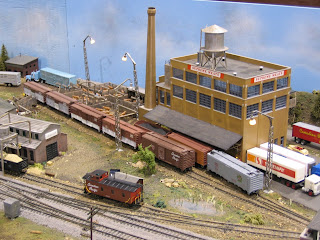Some think that model railroading is an art. Others think
that art is model railroading. Kim Adams is in the latter camp.
Born in Edmonton in 1951, Adams is considered one of
Canada's leading contemporary artists. His installation art has been exhibited
throughout Canada and internationally since the late 1970s.
To make his art, he uses commonplace objects such as auto
parts, household objects, toys and, yes, model trains to create sculptures that,
according to the Art Gallery of Ontario (AGO), “resemble fictional worlds and
imaginary landscapes.”
Reading that, I had to think: That sounds like most model
railroaders I know.
Like Adams, we are forever finding ways to use ordinary
items on our layouts—mostly because we are cheap and want to save money.
Like Adams, we also strive to create fictional worlds and landscapes.
Like Adams, we also employ “a careful, laborious approach,”
as the AGO describes his artistic method.
Like Adams, some of us also populate our layouts “with
scores of people engaged in a dizzying variety of activities.”
Unlike Adams, however, nobody gives us awards and money for our “art.” For his
efforts, Adams was awarded the $50,000 Gershon Iskowitz Prize
from the AGO.
Also unlike Adams, we don’t use rolling stock like he
does—piling them on top of each other and filling hopper cars with dirt and
turning them into gardens. That’s what he did for Artist's Colony (Gardens),
currently on display at the AGO. (See photos this page.)
But I’m not complaining; my hat's off to Adams for doing what
he does and winning the big prize.
All I have to say is that if an art critic is reading this
blog post, feel free to send me a note. I’ll be happy to put my layout on
display.
If it helps, I might even glue some rolling stock on top of
each other.
For more information and photos of
Adams’s work, click here.
-4-660.jpg) |
| A novel way to use hopper cars . . . . |
-8-660.jpg) |
| A new way to think of a "stack" train. |


































-2-660.jpg)
-4-660.jpg)
-8-660.jpg)

